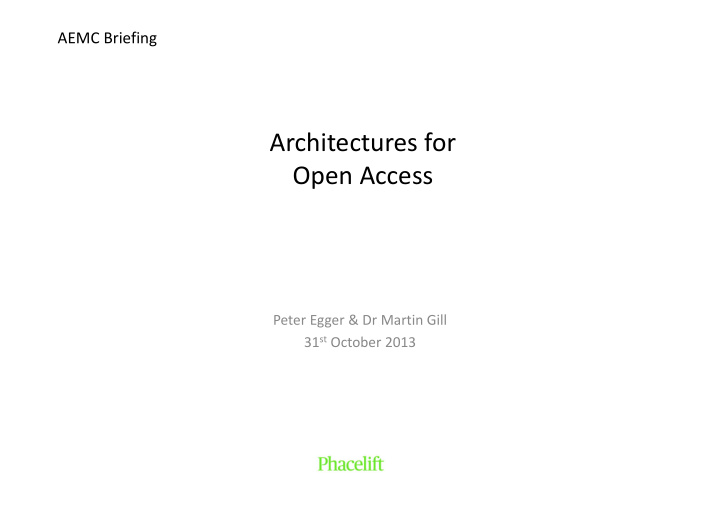



AEMC Briefing Architectures for Open Access Peter Egger & Dr Martin Gill 31 st October 2013
AEMC Workshop Agenda 1. Architectures as Access moves through Closed Metrology Functions Advanced Functions Direct Access 2. Possible problems with smart meter communication details 3. Questions 4. Appendix – The Access Spectrum Architectures for Open Access v01 2
AEMC Workshop Architectures (1) The Power of Choice What level of Interoperability and Access is required to support the aims of the Power of Choice (PoC)? Direct Access Access Spectrum ? In the following slides the Advanced Functions described functionality is additional to that Metrology described at the lower Functions levels Closed Not Interoperable Protocol Translation Common Protocol Interchangeable Interoperability Spectrum Architectures for Open Access v01 3
AEMC Workshop Architectures (2) Closed Accredited Parties not given access to the smart meters Architectures for Open Access v01 4
AEMC Workshop Architectures (3) Metrology Functions Meter Data made available to Accredited Parties (does not consider who is performing validation and substitution) Architectures for Open Access v01 5
AEMC Workshop Architectures (4) Metrology Functions Supports low volume of simple commands e.g. re/dis ‐ connect Commands may be processed manually Architectures for Open Access v01 6
AEMC Workshop Architectures (5) Advanced Functions Accredited Parties provided with indirect access to functions defined in the rules. e.g. status of the supply contactor is read from the database (not direct from the meter) Architectures for Open Access v01 7
AEMC Workshop Architectures (6) Advanced Functions Access provided to all functionality defined in the rules Automated two way exchange Architectures for Open Access v01 8
AEMC Workshop Architectures (7) Direct Access Smart meter operator checks security credentials of Accredited Party then provides direct access to all functionality supported by the meter Architectures for Open Access v01 9
AEMC Workshop Architectures (8) Direct Access All Accredited Parties interact directly with the smart meter Note that the Smart Meter Operator is considered to be another party accessing the meter remotely Architectures for Open Access v01 10
AEMC Workshop Example Architectures for Open Access v01 11
AEMC Workshop Example (1) Example of communication details National Electricity Rules Section 7.5.2 Metering register information Metering information to be contained in the metering register should include, but is not limited to the following (c) Data communication details, including: (1) telephone number(s) for access to energy data; (2) communication equipment type and serial numbers; (3) communication protocol details or references; (4) data conversion details; (5) user identifications and access rights; and (6) 'write' password Architectures for Open Access v01 12
AEMC Workshop Example (2) Smart Meter communication details Using the Metering Register to contact a meter It may not be possible for Accredited Parties to use the meter’s IP address to contact the meter Architectures for Open Access v01 13
AEMC Workshop Example (3) Smart Meter communication details (cont) It is not possible to directly contact Private IP Addresses The cost of obtaining and maintaining Private IP addresses is lower than Public IP addresses Architectures for Open Access v01 14
AEMC Workshop Questions Architectures for Open Access v01 15
AEMC Workshop Appendix Architectures for Open Access v01 16
AEMC Workshop Appendix (1) Smart Meter Functionality New (and specialist) Functions New e.g. Inverter Power Factor control Functions Advanced Functions typically found Advanced in Smart Meters and recognised in Functions the Rules e.g. Enabling HAN devices Functionality required to support Metrology the market and sufficiently stable Functions to be documented in the Rules Architectures for Open Access v01 17
AEMC Workshop Appendix (2) Access to Meter Functionality Direct Accredited Parties able to access meters directly and use ALL functionality Access (generally referred to as “Open” Access) e.g. Use of the Public Telephone Network to read meter types 1 to 4 Advanced Accredited Parties able to access advanced meter functionality Functions e.g. Enabling and disabling HAN devices Metrology Accredited Parties can access meter functionality defined in the rules Functions e.g. AEMO B2B Gateway Closed Accredited Parties not given access to meter functionality Architectures for Open Access v01 18
Recommend
More recommend